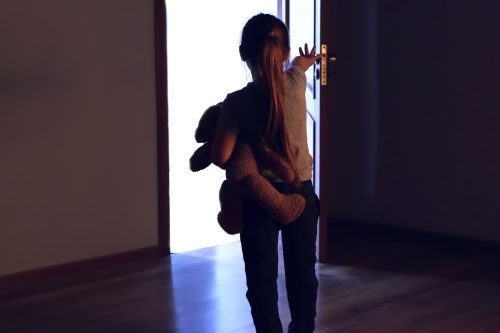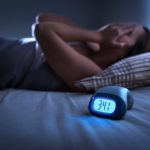Karen Lee, MD, a member of the Sleep Medicine and Surgery Division at Mass Eye and Ear, Longwood, explains the science behind unwanted sleep behaviors.
Sleepwalking and sleep talking are often regarded as punch lines pulled straight from a sitcom. A person caught stumbling around their kitchen or talking in their sleep might wake up the next day to a few laughs.
But these behaviors are no joke. They fit under a wide umbrella of unwanted sleep activities referred to as parasomnias. Karen Lee, MD, a sleep neurologist at Mass Eye and Ear, spoke to Focus about these unwanted behaviors and how they relate to irregular brain activity.
“A lot of these activities might sound comical,” said Dr. Lee. “But, when you understand how the body is supposed to function during sleep, you will see how these activities can be a sign of something much more dangerous.”
What happens when we sleep?
When a person falls asleep, the brain rotates in and out of four different stages of a sleep cycle. People typically complete a full cycle four-to-five times a night, with each cycle lasting anywhere between 90 to 120 minutes, on average.
The first three stages of the cycle are categorized as non-rapid eye movement (non-REM) sleep. During non-REM sleep, the body’s muscles tend to be relaxed, which enables limbs to move freely and, in some cases, allow the person to speak. In these stages of sleep, individuals often do not recollect talking, moving or walking in their sleep, and usually do not dream.
Dreaming occurs when the brain enters REM sleep, the fourth stage of the sleep cycle. A unique pattern emerges, whereby all muscles in the body are paralyzed, except those that allow movement of the diaphragm, to help control breathing, and eye muscles, which twitch back and forth in a horizontal direction.
Whichever stage a person wakes up in determines whether or not they can recall their dream. If someone wakes up in the middle of a REM sleep stage, or directly after it, they can recall the dream they just had. However, by entering a non-REM sleep stage, a person can no longer recollect what they’ve dreamt. This means that a person usually won’t remember their dream if they wake up during a non-REM sleep stage.
“A lot of people tell me they don’t dream at all, which often is not the case,” Dr. Lee said. “When evaluating a sleep study, I can tell by the patterns of their brain waves and eye movements how many times they’ve entered REM sleep stages, which could be four or five times a night. However, if they aren’t waking up during, or at the end of, their dream cycles, they likely won’t recall any of their dreams.”
Parasomnias throughout the sleep cycle
 While the exact cause of parasomnias remains a mystery, experts have uncovered some of its most common triggers. An irregular sleep schedule, sleep deprivation, stress, alcohol or other drugs and ambient light and sound can all cause arousals out of each sleep cycle stage. This can result in sleep walking, talking, paralysis or night terrors, among other parasomnias.
While the exact cause of parasomnias remains a mystery, experts have uncovered some of its most common triggers. An irregular sleep schedule, sleep deprivation, stress, alcohol or other drugs and ambient light and sound can all cause arousals out of each sleep cycle stage. This can result in sleep walking, talking, paralysis or night terrors, among other parasomnias.
The vast majority of parasomnias occur during non-REM sleep, which is why people often wake up with no recollection of talking, walking or, in some cases, eating in their sleep, unless their sleep partner catches them in the act and arouses them from their sleep.
“You often hear about people who walk into their front yard or eat half a cake in their kitchen with no idea of how they got there in the first place,” Dr. Lee said. “This can be extremely dangerous, especially if the person falls out of bed, wanders into the street or eats something that is inedible, such as a cigarette butt.”
The most dangerous type of parasomnia is REM sleep behavior disorder (RBD). RBD occurs when the switch inside the brain responsible for paralyzing muscle movements during REM sleep malfunctions. This allows a person to act out the movements they perform inside their dream. To make matters worse, these dreams are often violent and intense, such as someone running away in terror, an athlete playing a game of basketball or a professor lecturing a full audience.
“Imagine suddenly taking the breaks off a car that already has its pedal to the metal,” Dr. Lee said. “I’ve seen people act out these intense dreams and wind up in the ER with lacerations, fractured skulls and broken necks. They’re petrified of ever falling asleep again.”
Treating parasomnias
Recent studies have further underscored the dangers of RBD. According to Dr. Lee, the condition has been linked to a rare form of dementia and Parkinson’s disease, and its symptoms can predate Parkinson’s disease by 20 years. The severity of RBD heightens the importance of distinguishing one type of parasomnia from another – and from other types of sleep disorders.
Sleep neurologists treat parasomnias by first ruling out triggers from other potential sleep disorders, such as sleep apnea. Asking a person whether or not they recall the dream they were unintentionally acting out can help distinguish RBD from a non-REM parasomnia.
“RBD patients tend to recall a vivid story that matches the movements of their parasomnia episode, which is a symptom rarely associated with non-REM parasomnias,” Dr. Lee said. “If they’re mumbling or moving in their sleep and they recall dream content that matches this behavior, then that’s a major red flag.”
A neurologist then evaluates the results of an at-home or in-office sleep study to differentiate the specific type of parasomnia.
Treatments for RBD can closely align with those for non-REM parasomnias. According to Dr. Lee, lifestyle changes are recommended in both cases. A regular sleep schedule, less stress and a familiar sleeping environment can prevent arousals in the middle of a sleep cycle that can lead to parasomnias. Medications, such as anxiolytics, are usually prescribed if the parasomnias are intense, frequent or disruptive to the individual or their bed partner, and patients are encouraged to avoid aforementioned triggers, such as alcohol or all-nighters.
“Knowing when and how these parasomnia activities occur is a matter that needs to be taken very seriously,” Dr. Lee said. “By undergoing a sleep test and avoiding certain triggers in their sleep environment, individuals can minimize potential risks.”
About Our Expert
Karen Lee, MD , is a board-certified neurologist who is fellowship trained and board-certified in sleep medicine. She specializes in adult and pediatric sleep medicine, and her interests include narcolepsy, REM sleep behavior disorder, restless leg syndrome, obstructive sleep apnea and chronic migraines. Dr. Lee sees patients at Mass Eye and Ear, Longwood.
, is a board-certified neurologist who is fellowship trained and board-certified in sleep medicine. She specializes in adult and pediatric sleep medicine, and her interests include narcolepsy, REM sleep behavior disorder, restless leg syndrome, obstructive sleep apnea and chronic migraines. Dr. Lee sees patients at Mass Eye and Ear, Longwood.

